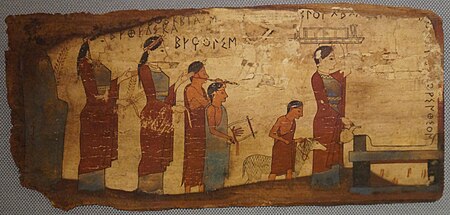Pitsa boards
The Pitsa tablets were found in 1934 in the Pitsa cave near the village of Ano Pitsa , in the west of Corinthia , in what is now Greece . There are four painted wooden panels dating from 540 to 500 BC. To date. They are the oldest surviving examples of Greek panel painting ( pinakes ), although two panels are poorly preserved. They are votive offerings to nymphs . All four panels are now in the National Archaeological Museum of Athens . However, the panels exhibited in the museum are copies made by the Swiss painter and restorer Emile Gilliéron fils . The originals are stored under air-conditioned conditions to prevent them from decaying. They have the inventory numbers 16464–16467.
General
The four panels are the only evidence of Corinthian painting from the 6th century BC. The inscriptions are also important finds for research into the development of the Corinthian alphabet . The good state of preservation is attributed to the fact that lime crystals were deposited on the tablets and the cave was hermetically sealed by a landslide.
The paintings are applied on a white stucco layer on cypress wood in tempera paint with the use of mineral pigments . The outlines were made in black and red. The color spectrum consists of white, red, blue, yellow, purple, brown, green and black. The colors were only applied opaque, there are neither gradations nor color gradients.
Plate No. 16464
The best preserved plaque is 31 cm long and 14 cm high and shows a sacrificial scene. Seven people are depicted, all facing to the right where there is an altar. On the far right you can see a young priestess holding an oinochoe in her right hand. On top of her head she balances a canoe , an offering basket on which there is a box and two vessels. Behind her is a boy with a lamb. Two young musicians follow. One plays a lyre, the other plays an aulos . This is followed by two women holding branches and a not well-preserved figure of a man. The fabrics are painted in red and blue. The hair and various details are black. The skin of men is red, while the skin of women is that of the light background.
The figures have inscriptions which they name by name. The women are called Ethelonche, Euthydice and Eucolis. A dedicatory inscription says that the tablet was dedicated to the nymphs . The painter signed the work, but his name has been lost, only the addition The Corinthians can still be read. So the painter came from Corinth. The inscription uses the Corinthian alphabet. It dates from between 540 and 530 BC. Chr.
Plate No. 16465
The panel fragment shows the lower part of three women and a cat. The women are probably nymphs. They wear a chiton and a himation over it . The inscription on the side reads Dedicated to the nymphs . It dates from between 540 and 530 BC. Chr.
Plate No. 16466
The panel fragment measures 12.8 × 19.3 cm. It shows a person in himation holding a necklace. The inscription is difficult to read and can no longer be understood today. It dates from the last quarter of the 6th century BC. Chr.
Plate No. 16467
While the 32 × 15 cm panel is almost completely preserved, only the upper right part of the painting exists. You see six women dancing in circles . Their heads are covered with a scarf and they wear golden wreaths over them. Other figures can still be seen as "shadows" on the wood. There are inscriptions from which only the name Telesoio can be clearly read. The tablet dates from the late 6th century.
literature
- Basil Petrakos : National Museum. Sculpture-Vase-Bronzes , Klio, Athens 1981, pp. 162, 165
- Konstantinos Kissas (ed.): Antike Korinthia , Athens 2013, pp. 150–151
- Konstantinos Zachos [Κωνσταντίνος Λ. Ζάχος]: Σπήλαιο Πιτσών. In: Archeologia . Issue 15, May 1985, pp. 23-25. PDF Online (Greek)
Web links
Individual evidence
- ↑ Dimitris Plantzos: The Art of Painting in Ancient Greece , Athens, 2018, ISBN 978-618-5209-20-9 , pp. 87-89



